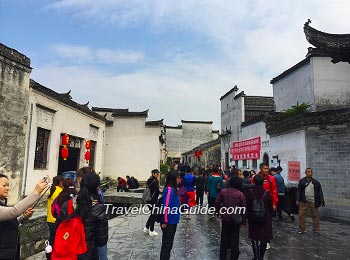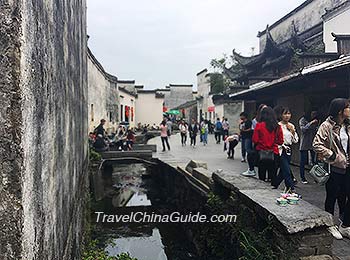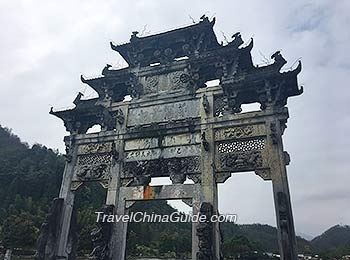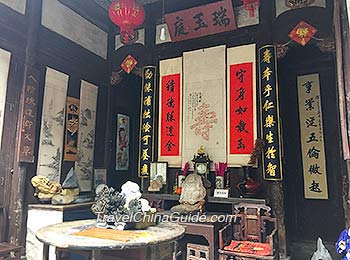Xidi Ancient Village
Xidi Ancient Village in Yixian County is about 40km (25 miles) south of Huangshan Mountain. Encircled by green hills, two streams flow through the village from the north and the east converging at Huiyuan Bridge. The village has two main streets and about 99 lanes paved with cobblestones or black stones. The residences, lanes and streets fit well with the hills and streams.
Construction of Xidi Village began during the Northern Song Dynasty (960 - 1127). So far, it has a history of over 900 years. Listed as a World Heritage Site, the village encompasses many historical and cultural sites.
124 well-preserved Ming and Qing (1368 - 1911) residences stand in Xidi Ancient Village. Walking into a residence, you will first see a pair of meaningful couplets on the wall opposite the hall gate. Stepping into the hall, you can appreciate the gorgeous colored paintings on the ceiling, which were popular at that time. Most of paintings and furniture date from the Ming and Qing dynasties. Among those residences, only some are open to the public including Linyun Pavilion, the Eastern and Western Gardens, Ruiyu Courtyard, Taoli Garden, Da Fu Grand House and Lufu Hall.
Carvings on wood, stone and brick are an important part of these residences. Tourists can appreciate these exquisite carvings on door frames, lattice walls, columns and beams in the halls. The birds, flowers, grass and figures on them are vividly presented. Both the Ming and Qing dynasty carvings display poise and refinement.
As an important landmark of Xidi Village, the archway was built during the Ming dynasty (1368 - 1644) in memory of Hu Wenguang, a Ming officer. Situated in the southwest of the village, the archway is 12.3m (40.4 feet) high and 9.95m (10.9 yards) wide. Consisting of 4 columns and 5 roofs, the archway is decorated with stone carvings in the shapes of deer, cranes, tigers, lions and the Eight Immortals of Chinese legends.
The Da Fu Grand House, built during the Qing dynasty (1644 – 1911), is located on the main street of Xidi Village. It’s an old residence of the Hu family. The doors of the main hall are carved with plum flower patterns and the windows with paper cuts in the Ming style.
Beside the main hall stands a two-story boudoir facing the street. Nowadays, locals hold performances in the Da Fu Grand House, and the most wonderful one is Throwing Embroidered Ball from the boudoir. If interested, you can join in by trying to catch the ball.
The best time to visit Xidi Village is spring and autumn. If you visit in March or April, you can appreciate plenty of rape flowers around the village!
1. Tunxi to Xidi, you can take the bus from Huangshan Bus Station to Hongcun Ancient Village, which passes by Xidi, and visitors can be dropped off here. It runs once per hour from 8:00 to 16:00.
2. The bus from Huangshan North Railway Station to Hongcun also passes by Xidi, and it runs once per hour from 9:25 to 17:25.
3. Tangkou to Xidi Ancient Village, the buses depart at 9:30 and 15:30; or you can share a taxi or car with other visitors, and the fare is around CNY20.1. Take a tourist bus straight to Xidi, once per hour from 9:00 to 17:00.
2. Take a returning bus to Huangshan North and get off at Xidi; the bus is available once per hour from 8:30 to 16:30.
3. Take a taxi or private car to Xidi Village. The taxi fare is around CNY70.
 Recommended Guided Tours to Xidi Village:
Recommended Guided Tours to Xidi Village:
5 Days Huangshan Photography Tour from $799
 Top 9 Things to Do in Huangshan
Top 9 Things to Do in Huangshan
Construction of Xidi Village began during the Northern Song Dynasty (960 - 1127). So far, it has a history of over 900 years. Listed as a World Heritage Site, the village encompasses many historical and cultural sites.
|
|
124 well-preserved Ming and Qing (1368 - 1911) residences stand in Xidi Ancient Village. Walking into a residence, you will first see a pair of meaningful couplets on the wall opposite the hall gate. Stepping into the hall, you can appreciate the gorgeous colored paintings on the ceiling, which were popular at that time. Most of paintings and furniture date from the Ming and Qing dynasties. Among those residences, only some are open to the public including Linyun Pavilion, the Eastern and Western Gardens, Ruiyu Courtyard, Taoli Garden, Da Fu Grand House and Lufu Hall.
Carvings on wood, stone and brick are an important part of these residences. Tourists can appreciate these exquisite carvings on door frames, lattice walls, columns and beams in the halls. The birds, flowers, grass and figures on them are vividly presented. Both the Ming and Qing dynasty carvings display poise and refinement.
Hu Wenguang Memorial Archway
|
|
Da Fu Grand House
Beside the main hall stands a two-story boudoir facing the street. Nowadays, locals hold performances in the Da Fu Grand House, and the most wonderful one is Throwing Embroidered Ball from the boudoir. If interested, you can join in by trying to catch the ball.
Best Time to Visit Xidi Ancient Village
How to get to Xidi Ancient Village
From Huangshan:
2. The bus from Huangshan North Railway Station to Hongcun also passes by Xidi, and it runs once per hour from 9:25 to 17:25.
3. Tangkou to Xidi Ancient Village, the buses depart at 9:30 and 15:30; or you can share a taxi or car with other visitors, and the fare is around CNY20.
From Hongcun Ancient Village:
2. Take a returning bus to Huangshan North and get off at Xidi; the bus is available once per hour from 8:30 to 16:30.
3. Take a taxi or private car to Xidi Village. The taxi fare is around CNY70.
| Entrance Fee | CNY104 |
|---|---|
| Opening Hours | 7:30 - 18:00 |
5 Days Huangshan Photography Tour from $799
- Last updated on Jun. 12, 2024 by Gabby Li -



